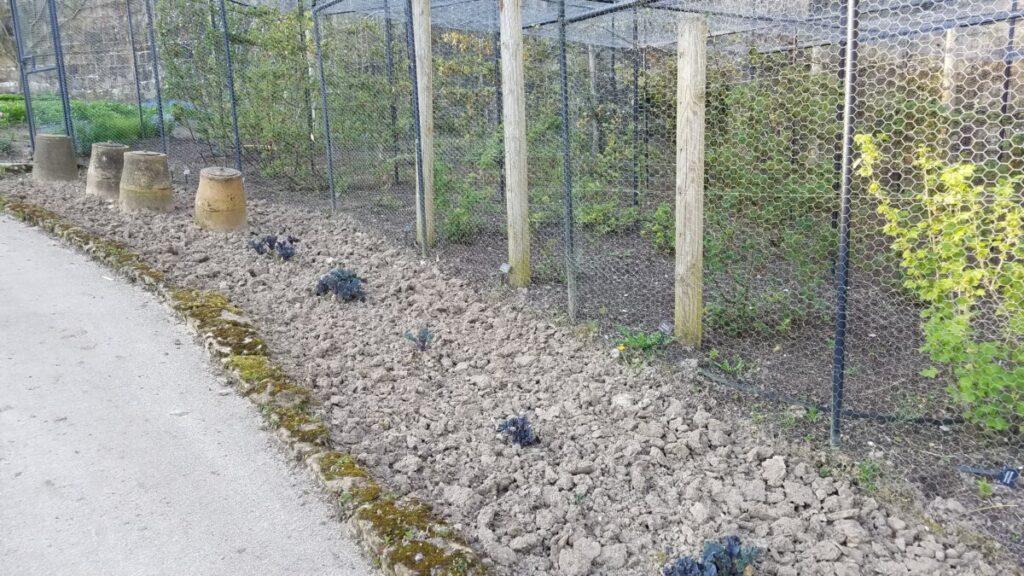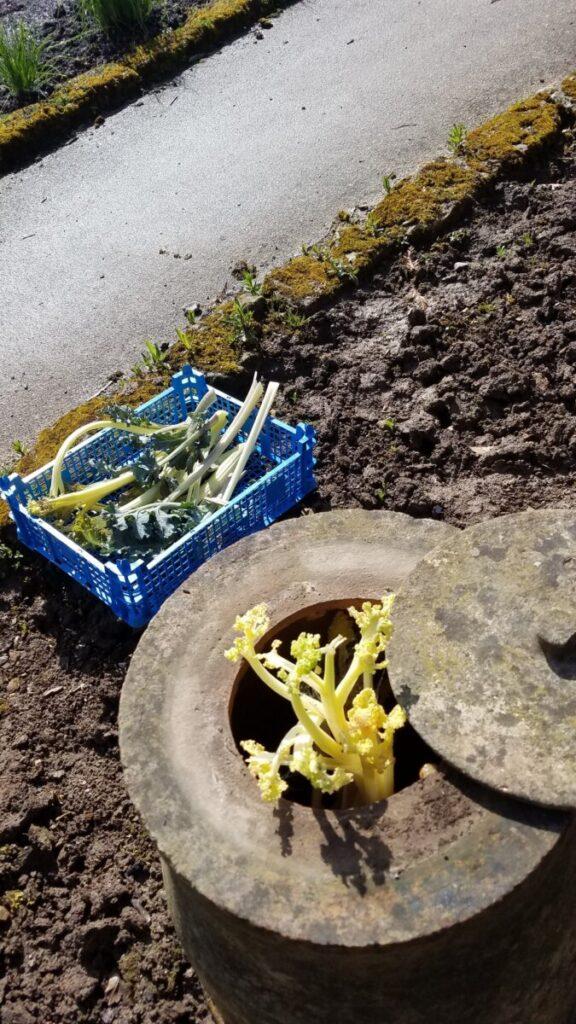
Growing Delectable Sea Kale in the Kitchen Garden
Story
My first experience with growing delectable Sea kale in the kitchen garden was at Gravetye Manor. In early spring I noticed several gorgeous terracotta pots neatly arranged in one of the vegetable beds. For some reason though, they were upside- down and had a removable lid. Naturally, I was very intrigued by this and proceeded to interrogate the kitchen garden supervisor about her upside-down pots. I came to find out this is a method of forcing or blanching certain crops to produce sweeter tasting vegetables. These particular pots were covering Crambe maritima.




Sea kale was once a popular vegetable in Europe, particularly in the 18th and 19th centuries. It was cultivated in gardens and forced in greenhouses to produce tender shoots for early spring consumption. However, its popularity declined in the 20th century, and it is now considered a rare delicacy. Today, sea kale is primarily found in upscale restaurants and specialty markets. It is valued for its unique flavor and texture, as well as its historical significance. Some chefs use sea kale as a substitute for asparagus or artichokes, while others feature it as a standalone dish. It is also used in salads and soups.
When I returned to the states I promptly made sure it was integrated in the kitchen garden at Hagley Museum and Library where I worked for several seasons. I missed that crunchy mild sweetness of the sea-kale and was very excited to begin forcing them myself. I’ve made sure to make room for this delectable plant in my own garden. Nothing better than a plant that will feed you in the spring and provide beauty to the garden later in the growing season.
Description
Crambe maritima, also known as sea kale, is a perennial plant that grows along the coasts of Europe, North Africa, and Western Asia. It has large, fleshy, blue-green leaves and produces clusters of white or pale yellow flowers in the summer.
In culinary use, the young shoots and leaves of sea kale are harvested in the spring and used as a vegetable. They have a mild, slightly sweet flavor and can be eaten raw or cooked. Sea kale is often blanched to reduce bitterness and enhance tenderness before being cooked. It can be boiled, steamed, or sautéed and is often served with butter or hollandaise sauce. It is important to note that Sea-Kale is a perennial plant. This characteristic allows the plant to be forced. Other perennial vegetables that can be blanched include asparagus and rhubarb.
As you can probably infer, the common name is derived from its most common characteristics, which is its distribution along the coast and its Brassicaceae family flowers, which Kale belongs to as well.
Growing Delectable Sea Kale




Sea kale, requires certain cultural practices to ensure optimal growth and health. Here are some cultural practices that are recommended for this plant:
- Soil preparation: Sea kale prefers well-draining soils that are rich in nutrients. Before planting, it is recommended to prepare the soil by incorporating organic matter such as compost or well-rotted manure.
- Planting: Sea kale can be propagated from seeds or root cuttings. (This plant will reseed freely so manage it with that in mind) Planting is typically done in the spring, after the last frost. Seeds should be sown directly in the soil, while root cuttings should be planted about 2 inches deep.
- Watering: Sea kale requires moderate watering, particularly during the growing season. It is important to avoid overwatering, as this can lead to root rot. Watering should be done in the morning or evening to reduce water loss due to evaporation.
- Fertilization: Crambe maritima is a heavy feeder and requires regular fertilization. It is recommended to fertilize the soil with a balanced fertilizer during the growing season.
- Mulching: Mulching can help to conserve moisture in the soil and suppress weeds. A layer of organic mulch, such as straw or bark chips, can be applied around the base of the plant.
- Pruning: Sea kale can be pruned after the growing season to remove any dead or damaged branches. This can help to promote new growth in the following season.
- Pest and disease control: Sea kale is relatively pest and disease-resistant, but it can be affected by aphids, slugs, and fungal diseases. Regular monitoring and early intervention can help to prevent or control these problems.
Overall, cultural practices for crambe maritima involve providing optimal growing conditions, regular fertilization and watering, and monitoring for pests and diseases. With proper care, sea kale can thrive and produce a bountiful harvest.
Design

Crambe maritima can be a great addition to a garden design, particularly in coastal or seaside gardens. Here are some tips for using it in garden design:
- Choose the right location: Sea kale prefers a sunny location with well-drained soil. It can tolerate some salt spray, but it is best to plant it in a protected area to avoid damage from strong winds.
- Plant with other coastal plants: Sea kale is a natural fit for coastal gardens and can be paired with other seaside plants such as beach grass, sea lavender, and sea holly.
- Use as a focal point: The large, fleshy leaves of sea kale can make it a striking focal point in a garden bed. Consider planting it in a group or as a standalone specimen plant.
- Pair with contrasting textures: The large, smooth leaves of sea kale can be paired with plants with contrasting textures, such as spiky yuccas or fine-textured ornamental grasses.
- Incorporate in a mixed border: Sea kale can also be used as part of a mixed border, with other perennials and annuals. Consider pairing it with spring-flowering bulbs or summer-blooming perennials for a seasonal display.
- Add to a seaside container garden: Sea kale can also be grown in containers, making it a great addition to a seaside-themed container garden. Pair it with other coastal plants such as succulents or trailing vines.
Remember to provide adequate space for sea kale to grow, as it can reach up to 3 feet in height and width. With its unique foliage and culinary uses, crambe maritima can add interest and flavor to any garden design.




